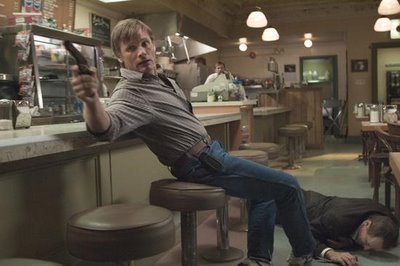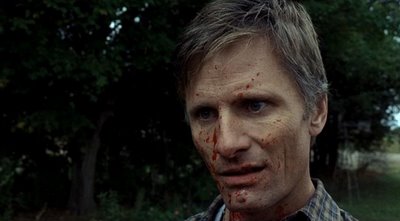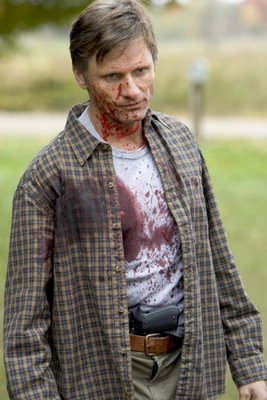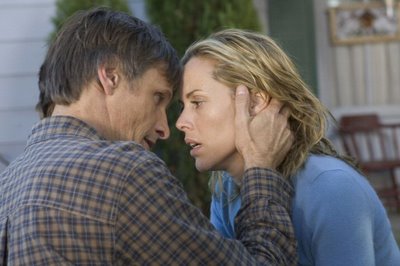
A History of Violence is another Cronenberg adaptation, this time from a graphic novel, opening up a cherry pie, backwater America. The title reading more like a case workers notes than a documentation of violent progression in society, this film cracks open America’s pie crust and reveals a dark past.
Often reviewed as the most un-Cronenberg film he has made to date, Cronenberg’s latest offering is a tale of emergent past. An every-mans story exaggerated and emphasised. The lurking violence of the past, an ever present history, and a hidden identity. Cronenberg deals again with a sense of duality, as with Naked Lunch, and Dead Ringers, A History of Violence holds a volatile presence, ready for the balance to tip, or the surface to be scratched, this time an ever present horror that emerges from a hidden past.

Cronenberg’s most subtle horror, in terms of viscerality, works within a typical Gangster/Revenge plot working with the “Wrong Man Scenario”. Characters echo those seen in film-noir and the old “black hat - white hat” cowboy flicks.
With the mutants stripped away and one of the most stereotypical Cronenberg dream sequences cut from the final film, this is a skin and bones Cronenberg tale of a delicacy that is lacking in some of his former works.
A character with a dual identity, one hidden (Joey) and one composed (Tom); the protagonist is a calm picket fence American living in a small town that would not be out of place in one of Lynch’s cinematic offerings. The violence in this film, the portrayal of small everyday America and the lead gangster Fogarty are all reminiscent of Lynch’s Blue Velvet.
Tom owns a diner, has a wife and 2 kids, and is a pillar of his community who is elevated to hero status by thwarting a robbery in his diner.

***THE EMERGENCE OF JOEY (this bit’s full of “spoilers”)***
The first emergence of Toms Other (Joey) doesn’t happen in the diner, the place where it is first recognised and brought to light in the “mistaken identity” sequence of the movie by the Philadelphia Gangsters, but when Tom’s son Jack has retaliated against his school bully in an unrelenting violence that springs as if from nowhere, (possibly relating to the surprise and equally violent response from Tom in the diner robbery earlier in the film). Tom strikes his son Jack for his insolence and this is the first un-masking of Joey. In this strike the surface paint that is Tom is scratched and Joey’s colours can be seen underneath by his son. Although it seems that Joey has emerged from within Tom in the diner robbery, Tom is still a submissive character and his wife still plays in the dominant role, shown by her confrontations with the gangsters both in the diner and in the shopping centre compared to Tom’s submissive diffusions of conflict.
Tom’s passivity is not destroyed by the rising of Joey until his confrontation in the garden when his son and wife are secretly watching his violence; Tom has for the first time responded to the name Joey and his son looks at him as a stranger, the emergence of Joey is complete.

The division of the character is emphasised as the plot thickens, the otherness is released from Tom by his intruding past, and it starts a chain reaction that reveals his hidden persona. With the first questioning of Tom by the gangster Fogarty (when they first come to town), Tom’s expression is blank and takes the blunt questioning in his stride as the small town presence in the diner keeps his balance towards Tom, the identity of Tom is kept stable by his surroundings, Toms identity and its construction is inextricably tied to place. The small town reinforces his boundary, as at this point in the film, with his wife and yokel friends by his side he is Tom.
Sam the detective asks Tom if he is in witness protection and Tom replies with disbelief, as again he is with his family that shields him from his past but when Fogarty confronts Tom saying “you almost believe your own crap, you try so hard to be this other guy, its painful to watch”. Joey starts to surface, Tom’s facial expression changes, he sends his wife indoors so Joey can emerge, when his wife and son have left the Jackal to Hyde transformation is complete.

In the sexual act to follow this scene the violence is depicted as masculine virility, the sex is raw and violent and is a stark contrast to the passion seen earlier in the film. Tom is half Joey and hesitates for a second in disbelief at the emergence of his second character to his wife. In this hesitation his wife grabs Joey, leaving Tom behind. In this violent sex scene Joey and his wife’s animalistic violence are released. After the thralls of violent passion and Joey’s violence is accepted and embraced by his wife, Joey reverts to the submissive Tom. After the sex is over and the wife leaves in disgust, Joey leaves too, and Tom is left whimpering at her feet.

Tom refers (while laying in the hospital) to a 3 year period where he lives in the desert and kills Joey, where Joey dies and Tom is born, a rebirth. Tom’s otherness – (Joey) his violent other is referred to as dead by Tom, unlike Dead Ringers where Beverley’s other (Elliot) dies in the end sequence Joey is masked under the surface of Tom. As the film progresses and Joey overpowers Tom, (which only truly happens when Tom/Joey reaches Philadelphia) his character changes, his voice changes and he has transformed back into Joey.
Tom’s description of killing Joey is paralleled in one of the final sequences of the film when Joey washes himself in the Lake, a baron flat plane. Alone, Joey kneels by the lake side and baptises himself with water, topless and wearing a standard small town America issue silver crucifix, Tom washes away Joey and in the final sequence of the film can be reunited with his Family as Tom. He re-enters the house and is offered a place at the table by his Daughter, his son offers to break bread with him (because it is every-small-town-America the bread is replaced with Meatloaf).
The constant emergence and disappearance of the dual character in this film comes to an end in an almost iconic Christian metaphor, that although sits outside Cronenberg’s usual reference material draws a conclusion to the film where Joey has been washed away and Tom remains with his family.
Labels: Alan Hook, Canadian Cinema, David Cronenberg, Transformation, Viscerality



2 Comments:
A stunning film to end a great season. Consummate acting by both Mortenson and Bello (although that kid was as annoying as hell). A History of Violence is a film that I think always deserves at least a second viewing, because it’s so easy not to get. I seen this a few times with people who have said ‘it’s not a Cronenberg film’ (something that Alan spoke about in his intro) and others who hated the cheese factor, particularly evident in the beginning. Dave rightly pointed out that the beginning of the film doesn’t start of with the all-American, white picket fence, perfect family moment that we remember by the end of the film, it begins with the violent murder of a motel employee and maid by the gangsters that become the catalyst for Tom’s transformation back into Joey. This is a huge clue. The murder and violence hen underpin all of those stereotypical devices that Cronenberg traipses out for much of the rest of the film. Think. Soaring hero music, the all important baseball game, the best coffee and cherry pie in town. And the school bully looks like a Grease reject. Remember his car? It actually had silver lightening bolts sprayed onto the sides. And now I think about it, maybe that kid was supposed to make me want to throw up. It isn’t the most original play in the world to question the authenticity of the American Dream. It’s something we have long been familiar with in various other texts. However, what is special about the film is that it allows you to believe that it takes these stereotypes as truth at the same time as it questions their very existence. Neat trick.
To the ‘non-Cronenbergness’ of the film: it terms of the viscerality, actually it rates very high. As Alan rightly pointed out, there are no mutants, deformities , or biological perversions being shown as we may expect from films such as Videodrome or Naked Lunch but the moments during the film where Joey is kicking the crap out of somebody always seem to end, or be intersected with, shots that linger just a little too long. We see where Tom/Joey has forced the nasal bone of his attacker into the rest of his skull, or where the coffee jug Tom/Joey used as a weapon has shredded the side of another attackers face, exposing the cavity of the mouth. During these scenes, Cronenberg’s obsession with body horror/visceral gore is clear to see. Another argument against the non-Cronenbergness of the film comes from the moment where Joey emerges for the first time in front of his wife (played by the unnaturally beautiful Maria Bello). Bello is watching the scene unfold from the second floor window of their home. As Joey emerges, the sound of a fly buzzing around the windowpane can be clearly heard before finally we see the fly on screen. Arguably the most ‘Cronenberg’ of all Cronenberg’s films is The Fly, and this scene is a direct reference to that. The transformation occurring in Tom/Joey is no less significant that the transformation of man into insect portrayed brilliantly by Jeff Goldblum in that classic movie.
Finally, here is a link to a review of A History of Violence by J.G Ballard (probably the most important post-war British writer). An interesting read as Cronenberg directed Crash, adapted from Ballard’s novel of the same name. Enjoy:
http://film.guardian.co.uk/features/featurepages/0,4120,1576212,00.html
can't get that link to work above but it should if you type it in the address bar.
Post a Comment
<< Home